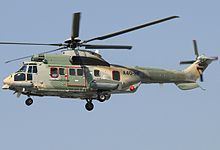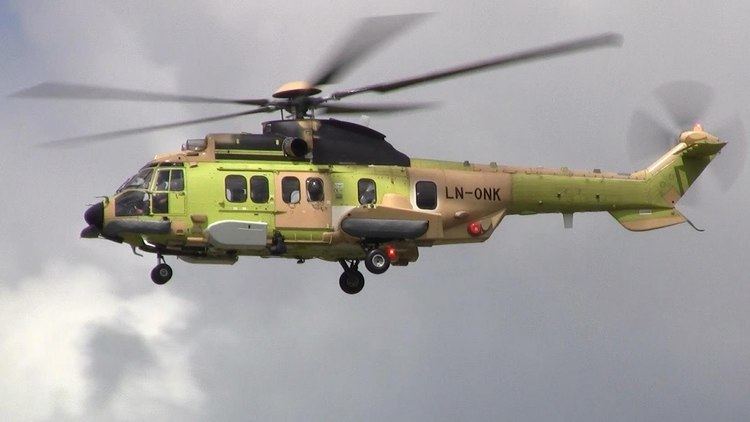Top speed 276 km/h Weight 5,256 kg Length 20 m | Range 838 km Cruise speed 262 km/h Wingspan 16 m | |
 | ||
Eurocopter ec225 super puma takeoff
The Eurocopter EC225 Super Puma, now known as the Airbus Helicopters H225, is a long-range passenger transport helicopter developed by Eurocopter as the next generation of the civilian Super Puma family. It is a twin-engined aircraft and can carry up to 24 passengers along with 2 crew and a cabin attendant, dependent on customer configuration. The helicopter is marketed for offshore support and VIP passenger transport duties, as well as public service missions.
Contents
- Eurocopter ec225 super puma takeoff
- Development
- Design
- Operational history
- Variants
- Military operators
- Civilian operators
- Accidents and incidents
- Specifications EC 225
- References

The civil-orientated EC225 has a military counterpart, which was originally designated as the Eurocopter EC725; it was rebranded in 2015 as the H225M. In 2015, the EC225 was formally renamed to the H225, in line with Eurocopter's corporate rebranding as Airbus Helicopters.
Development

In the aftermath of the 1973 oil crisis, oil and gas companies began exploration and extraction activities farther offshore, thus creating a long-term need for more capable rotary aircraft. The development of the EC225, an enlarged variant of the AS332 Super Puma, was announced by Eurocopter in June 1998. The principal differences of the EC225 from the preceding AS332 are the adoption of Spheriflex rotor technology and new Turbomeca Makila 2A turboshaft engines, along with a redesigned main gearbox to accommodate the rotor and engine changes, and the addition of an integrated flight display system; these changes resulted in higher speeds and passenger comfort, as well as greater flight safety and reduced operating costs.

On 27 November 2000, the first prototype performed its maiden flight. In July 2004, the type received its airworthiness certification from the European Aviation Safety Agency. In December 2015, the H225, a new designation used for the EC225, received certification from the Interstate Aviation Committee of the Commonwealth of Independent States; this made the H225 the first foreign heavy-lift helicopter to become certified in Russia.

In February 2014, Airbus Helicopters announced at Heli-Expo 2014 the development of an improved variant, the EC225e. The EC225e features numerous changes including new avionics systems, such as the TCAS II collision avoidance system, an automatic identification system, and a specialized rig-approach system; it was also intended to feature an improved Turbomeca Makila 2B engine to increase the EC225e's maximum takeoff weight by 550 kg, and an additional fuel tank in the rear baggage compartment to extend its range to 300 nautical miles with up to ten passengers on board. Some, but not all, modifications can be retrofitted onto existing EC225s. In the same announcement, in February 2014, Lease Corporation International said that they had placed a $645 million order for 15 EC225e (along with 6 Airbus Helicopters EC175) helicopters as the launch customer. In February 2016, the Makila 2B engine was dropped from the EC225e as a cost reduction measure, development of the other structural and avionics aspects is proceeding.

In 2015, Airbus Helicopters announced at the Paris Air Show that it had begun development of a clean-sheet successor to the EC225, initially designated X6. The EC225's production line has been projected to continue manufacturing activity until around 2030, initially overlapping with its successor.
Design
The EC225 is based on the Eurocopter AS332L2 Super Puma, improving upon the design with a five-blade main rotor incorporating a new airfoil shape to reduce vibration and noise levels. The blades of the rotors feature a composite spar and parabolic blade tips; they can also be equipped with an anti-icing system to enable the aircraft to operate within very cold climates. The helicopter is powered by two Turbomeca Makila 2A1 turboshaft engines mounted over the cabin; these engines are capable of providing 14 per cent more engine power and feature a redundant dual-channel full authority digital engine control (FADEC) system for high reliability, a further backup system is present in the event of both FADEC systems failing. The FADEC system ensures that engine power is always kept within the limits of the gearbox. Many of the mechanical components, particularly of the engines, were designed to be modular to ease maintenance, and composite materials were used where possible to reduce the aircraft's weight.
A key safety feature of the aircraft's main gear box (MGB) is an emergency oil spraying sub-system present in the lubrication system; this is designed to exceed the JAR 29 Standard's requirements of a 30-minute running time in the event of the loss of MGB oil pressure, and has demonstrated up to 50-minute running time. The engine also incorporates a "blade shedding" system to ensure engine integrity during an overspeed instance. Energy absorbent self-sealing fuel tanks are contained in the aircraft's sponsons, along with other equipment such as downward-facing illumination and navigation lighting fixtures. The transmission can accommodate more power than the maximum output of the engines; however two aircraft were lost in 2012 due to the cracking of the bevel gear shaft, a gearbox component. In response, the design of the transmission was modified in 2013, and the onboard health and usage monitoring system (HUMS) was upgraded to provide real-time monitoring of the bevel gear shaft against the threat of crack formation.
In terms of cockpit equipment and avionics, the EC225 is equipped with a full glass cockpit with active-matrix liquid crystal displays; these include four 6-inch by 8-inch multi-functional displays as the predominant instrumentation for key flight information, two 4-inch by 5-inch monitors for displaying aircraft parameters, and a 3-inch screen for backup. The advanced helicopter cockpit and avionics system is described as serving to reduce pilot and crew workload, being used to display flight management and sub-systems information and is complete with a four-axis digital autopilot. During a typical flight, the pilot programs the route into the aircraft and then monitors it, as opposed to direct continuous control of the flight; the need for paper charts has been eliminated by these systems. Under autopilot, the automatic flight control system acts to prevent pilot actions from exceeding the established flight envelope; the EC225 remains flyable with all automatic systems disabled. From initiating the startup sequence to being ready to takeoff only takes three minutes., however if you use the authorised Airbus checklist it will take approx. 7 minutes.
There are currently a total of four principal configurations designed by Airbus Helicopters for the EC225. The passenger transport version has a crash-worthy seating arrangement for up to 19 passengers with a high-density seating arrangement accommodating up to 28 passengers available to be fitted. The VIP transport version has a large lounge with seating for up to 12 passengers and a cabin attendant. The emergency medical services (EMS) configuration has medical units for six stretchers and four seats for medical workers. The search and rescue (SAR) configuration allows space for search and rescue equipment with an operator seat, hoistman seat and up to eight rescue seats and three stretchers. While a single pilot is capable of controlling the aircraft under visual meteorical conditions, two pilots are used in a typical crew compliment and, dependent on role, a cabin attendant or flight engineer may also be present.
Operational history
In January 2005, Algeria became the first country to use the EC225 when the Algerian Ministerial Air Liaisons Group (GLAM) took delivery of a single vehicle for VIP transport duties.
The EC225 was a candidate for the Norwegian All Weather Search and Rescue Helicopter (NAWSARH) to replace the Westland Sea King Mk.43B of the Royal Norwegian Air Force in 2015; other candidates were the AgustaWestland AW101, Bell Boeing V-22 Osprey, NHIndustries NH90 and Sikorsky S-92. By 9 July 2013, only the AW101 and the EC225 remained as contenders; in December 2013, the AW101 was selected instead.
In 2009, the AirKnight consortium offered the EC225 in competition against the Sikorsky S-92 offered by the Soteria Search and Rescue consortium for the United Kingdom's Search and Rescue – Helicopter (SAR-H) program to replace the RAF Search and Rescue Force's Westland Sea King fleet. In 2010, Soteria was awarded the contract; however, in 2011 the contract was halted as Soteria had access to confidential information. In 2013, the Department for Transport awarded Bristow Group the SAR-H contract, operating a mix of Sikorsky S-92 and AgustaWestland AW189 instead.
By 2011, CHC Helicopter had the largest operational fleet of EC225s, the type comprising a fifth of the firm's total rotorcraft by 2015. CHC principally use the type for serving the offshore oil and gas industries, as well as search and rescue missions. Another milestone was reached in 2011 when Eurocopter delivered the 100th production EC225 to Bristow Group. In March 2013, leasing company Milestone Aviation Group placed a record order for 30 EC225s.
Due to its popularity in offshore passenger transport, the EC225 is also commonly used as an offshore Search and Rescue aircraft, with operators based in Norway, the UK and Australia. In this role, aircraft are typically equipped with a Dual Rescue Hoist, FLIR camera, high-powered searchlights and an advanced autopilot with autohover capability. The EC225 has also been used as an aerial firefighting platform, it can be equipped with a Simplex Aerospace-developed water cannon for dealing with fires in built-up urban areas, both Japan and South Korea operate several aircraft adapted in this manner.
Following the 22 October 2012 crash, the major North Sea Super Puma operators, CHC Helicopter, Bond Offshore Helicopters and Bristow Helicopters decided to ground all AS332 and EC225 Super Puma helicopters. On 25 October 2012 it was announced that the problem was suspected to relate to the main gearbox vertical shaft; the AS 332 L1 and L2 versions of the Super Puma could be refitted with an older design, allowing them to resume flying. On 8 November 2012 some Super Pumas of Bond Offshore Helicopters returned to flight. The EC225 grounding continued into 2013, following the validation of new safety measures by the EASA, the type was progressively returned to service following modifications. By mid-2015, all 49 EC225s operating in the North Sea fleets in the UK had been retrofitted with a redesigned bevel wheel vertical shaft to avoid any recurrence.
In March 2015, the Japan Coast Guard accepted delivery of its fifth and final EC225; outfitted for performing search and rescue missions, they shall also be used for security enforcement, territorial sea enforcement/monitoring and disaster relief operations.
On 2 June 2016, following the crash of an H225 in Norway which revealed a potential safety issue with the main rotor assembly, the EASA issued an emergency airworthiness directive that grounded the H225 fleet; by July 2016, 80 per cent of the worldwide fleet had been grounded as a result, while some operators such as the French military continued to operate its fleet. In October 2016, the grounding order by the EASA was lifted; some countries, including the United Kingdom and Norway, chose to maintain operational restrictions for the type. Norwegian operator Statoil, who had contracted the CHC H225 which crashed, maintained it will not return to using the helicopter even if restrictions are lifted. The company has instead relied on the Sikorsky S-92 to meet its needs since the crash. By December 2016, three separate lawsuits were filed by separate H225 operators, claiming that the type had been sold in a defective state due to the flaw being "inherent".
Variants
Military operators
Civilian operators
Accidents and incidents
Specifications (EC 225)
Data from Airbus Helicopters
General characteristics
Performance
